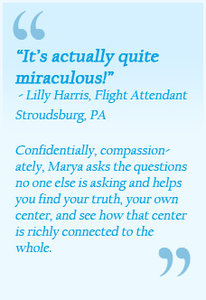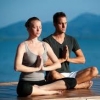Art in Bali - Remembering to Remember

I was working on my Ph. D. in Creative Arts when I first visited Bali, the tiny island in Indonesia where, it’s said, the gods spend their vacation.
Studying the practical psychology of liberation through the arts, I arose every morning at dawn, walked out to the sun-drenched wooden platform overlooking the Java Sea, and began my morning yoga practice. It was 1986, long before Yoga in Bali became a commercial goldmine, and it was still possible to informally visit temple priests and priestesses and village balian, or shaman, to explore the ancient ways of spirit, art, and life.
One balian massaged and manipulated my body into a wholesome bundle of samadhi while a temple priestess taught me to carry a 20-lb. tower of elaborate fruit and rice offerings on the top of my head. As scents of plumeria and incense filled the air, a revered spiritual teacher took me to temples for the dead, for the living, and for various deities who populate the seaside, farms, and high mountains as well as the eleven dimensions in the Balinese cosmology.
A Sanskrit scholar…
…whom I wanted to interview didn’t start by negotiating “best price” with an eye to making a quick buck. He assessed my genuine zeal for learning, and seeing my passion for truth, he offered whatever wisdom he had to me. It was only my insistence that convinced him to let me pay him for his time.
That was when the deeper teachings of yoga began to nourish me in new ways. My Balinese friends who had watched me practice every dawn were quickly compelled to ask me to teach them the asana, postural poses, and meditations that I had learned in Ashtanga – or 8-limbed – yoga classes in my hometown of Boulder, Colorado.
This was my first job as a yoga teacher! But it was not a one-way interaction. I learned what it means to live in a respectful community, aligned with the three levels of the soul, and connected with the Oversoul. Pak Batuan always emphasized how important it is if we wish to make authentic art, to stay in touch with our canda empat, the four siblings.
As loving guides or energy vitalities, the four siblings are born into this world with us. Lifelong companions who act as a spiritual board of directors, these four siblings advise us on everything, from what to eat, what work to do, who to marry, and even how to die well.
In the U.S., even at the highly respected Yoga Workshop where I practiced with the impeccable master, Richard Freeman, there was a dominance of the “myth of materialism.” How else in the 1980s could anyone fill their yoga classes?
Americans wanted yoga as an exercise, not as a spiritual practice. They were still mostly confused about the difference between yoga and Hinduism and Buddhism. Hinduism and Buddhism, like Christianity and Islam, are religions. Yoga is a practice that brings balance and clarity to life, no matter what your religion, or even if you’re an atheist.
Yoga supercharges your dynamic core with this magical substance known as Prana, the life force. Like Mana and Chi, this life force is universal; it strengthens the body and clears the mind, but it doesn’t tell you what to think or believe. Yoga asks you to rub the practices with your own experience and to choose for yourself what you know and wish to believe.
When I headed to Bali to study creative arts practices and their role in creating healthy communities, my theory was that spiritual practices were the basis for peaceful, non-violent communities. I worked with dancers, painters, and healers to find the common threads of belief and practice that produced joyful people, strong families, and a pervasive social and psychological balance that was already becoming rare in the U.S.
What was revealed to me was that the philosophy behind such captivating works as Walter Spies’ mind-bending choreography in the Kecak Monkey Dance, and visual artworks like Pak Batuan’s acrylic and oil paintings, had a tremendous influence on what was made. The purpose behind their art was far more important to the mystical artists of Bali than the actual material or media available to them.
I lived in Ubud…
…teaching yoga and studying dance in the mornings, and learning to paint with Pak Batuan in the late afternoons. It was right after he painted Yogi in Mountain Pose on Gunung Agung, the great volcanic mountain (pictured here), that I learned that Batuan had been a school teacher, headman of his village, an impresario of all the local Balinese Arts, founder of the Pengosekan Community of Artists, and that he personally met and even sold paintings to such unlikely people as Queen Elizabeth, Mick Jagger, Buckminster Fuller and the moon-walking astronaut Ron Evans, to name a few.
As he patiently showed me how to set the underlying tone of watercolor painting first, then bring in the meticulous line, and enhance it with details as guided by the spirits, I saw how the Balinese cosmology was central to every one of his paintings. He was partial to painting mandalas, although his jungle flowers and brightly feathered birds drew more dollars to him. Mandalas, in a vast variety of colors, sizes and designs, he said, all reflected the “unseen” world of Niskala, rather than the visible world of Sekala.
He produced beautiful work that decorated his public and private wall spaces “like hallucinogenic snowflakes,” according to one admirer. He painted for his fans, he said, but also for himself, to focus his soul. That is, of course, what all Balinese artists did before they learned to sell paintings to tourists. There was only ritual art, to focus the soul and give to the gods.
The philosophy of Balinese art…
…taught to me by Pak Batuan can be glimpsed in a few simple principles:
1 – Everyone, everything, each molecule, and every point in space has a soul.
2 – The purpose of life is to create more and more beauty.
3 – Behind every work of art is a “dimensional double,” the spiritual version of the material expression.
When we paint, he said, we’re remembering to honor the ancestors, the guides, and the cosmos that permeates our everyday lives. Painting, like yoga, helps us remember who we are and that we’re here on this Earth for a good reason.
There may be no greater time to remember to remember!
For more detail…
…please contact Kona Coast Yoga & Wellness at (808)345-0050. If you’d like to study silk painting with Marya, the next weekend workshop is November 17 & 18 at SKEA, the Society for Kona’s Education and the Arts. You can register by calling (808)328-9392.


